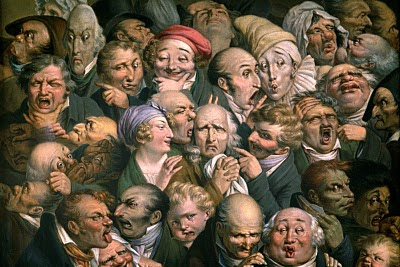
I have decided that I love the paintings of Louis Leopold Boilly. His paintings are so detailed, without becoming stiff stiff. His subjects are neither over-dramatic nor over-erotic. (That is a terrible explanation for why I like his paintings, my Art History teachers would cringe, but that isn't the point right now.) Anyway, Boilly was a painter who painted in France during the French Revolution. The paintings that I particularly like are his paintings of parties and multi-person events. I think these provide a nice glimpse of what fashion really looked like, considering the fact that no matter what the era, people dress diversely. Some people wear the older styles they are comfortable with, some people stay on the front edge of fashion, and all the rest of us land somewhere in-between.

The above painting is a really great depiction of men's clothing (not a woman to be seen, actually!). On the left side of the painting, we see a couple of older men, with rather more old-fashioned hairstyles. One of the men looks to be wearing a great-coat (or outer coat), but the other one is obviously wearing a frock-coat. His brown, double-breasted frock-coat has a narrow, curving cutaway, which is very high at center front. It has a very large lapels and a tall collar. His yellow (striped?) waistcoat looks like it buttons down center-front (not double-breasted), with high, symmetrical lapels. Note the low placement of the pockets. His brown breeches have a fall-front and stop just below the knee.
In the middle of the painting, there is a dapper young man who is obviously farther ahead in the fashion game. His frock-coat is a pale green. It has a wider, slightly lower cutaway in the front. The top collar of his coat is narrower than the older gentleman's, and although the lapel is rather obscured, it looks to be slightly smaller and less exaggerated. The young man's breeches are longer - they appear to fasten at the side, which implies that they are knee-breeches and not long pantaloons. Long pantaloons, as far as I have garnered from my research, were worn only for informal occasions until around 1810, after which they saw a rise in popularity. This is probably my favourite look so far. It is very trim and dapper.
Throughout the painting is evidence of varying styles; there is a man in a bright red coat (which I suspect is a short jacket, rather than a long frock-coat), many different colours and shades of coats and waistcoats, coats with different fits and various collars and lapel sizes, etc.

Above is another example of a wide array of styles. I won't comment in detail on this painting, but I will point out that the figure of a man in the lower right corner of the painting looks to be the exact same man in the Meeting of Artists! The painting looks to be a little romanticized - obviously not all women wore pristine white dresses with sweeping trains (even the little girl in the lower right has an impractically long train). However, it is probably a passing fair representation of everyday life, give or take a few details.

Game of Billiards is my new favourite painting. I love how homey and jovial the atmosphere is, and I really adore the figures in the centre of the painting - it is a little girl hugging her father, and it reminds me of running to hug my dad when he got home from a plane trip! This painting is obviously a set a little later than Meeting of Artists; if you look closely at the collars of the mens' frock coats, you can see how the notch is starting to emerge. According to Norah Waugh in The Cut of Men's Clothes: 1600-1900, the notched collar emerged around 1803 and stuck around until 1850ish. In this painting, however, the notch is still in its baby stages, and I can get a glimpse of how the collars started to merge.
No comments:
Post a Comment